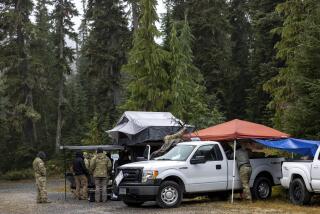Spirits Soar at Reunion of Pioneering Women Pilots
- Share via
SWEETWATER, Tex. — Mary Ruth Rance loved to climb into the cockpit of the PT-17 or the AT-6 and take off over the rich black fields of West Texas. She loved the roar in her ears and the sure, taut power of the controls. She loved knowing she could fly those World War II planes as well as any male pilot at Avenger Field. Maybe better.
“Even my instructor had to admit that,” Rance said. “And he was a man, of course.”
It was only yesterday; it was 50 years ago.
Rance, of Berkeley, Calif., and her comrades are in their 70s now, retirees and grandmothers. But one recent weekend, back at the airfield where it all began, they acknowledged that they also were unsung pioneers in the movement for women’s rights. As WASPs, Women Airforce Service Pilots, they were the first women trained to fly for the U.S. military.
In those fast-paced days of World War II, they were the pilots who picked up new warplanes at factories and delivered them to Army bases, who towed targets through the sky so male cadets could practice their gunnery. Twenty-five thousand women applied for the program, but only 1,830 were accepted. In 1943 and 1944, 1,074 of them won their wings.
Like an impressive number of other WASPs attending the reunion, Ola Rexroat of Corrales, N.M., was still able to fit into the trim, dark blue uniform she was issued a half-century ago. A military beret covered her white hair. Rexroat, whose nickname was “Sexy Rexy,” recalled how some of the male pilots used to try to get her goat.
They listed her in flight logs as the co-pilot on solo flights, as if a phantom male pilot had accompanied her. “All the men were against us,” she said. “We had to be just perfect.”
She and the others cheered wildly when the guest speakers, including Democratic Texas Gov. Ann Richards, heralded the breakthrough news in military aviation, that Air Force Lt. Jeanne Flynn had just been named to become the first female combat pilot.
“I could have done that back in World War II,” said Rexroat, 75. “We all wanted to fight, but nobody would hear of it.”
As it was, the WASPs were considered civilian employees of the military. Thirty-eight of them lost their lives in crashes, many while testing planes to be sent to overseas war zones. But not until 1977 were the WASPs granted full veterans benefits, and only very recently has their contribution been recognized by writers and movie makers. Several documentary camera crews followed the women around that reunion weekend, calling them “heroines.”
Their memories include many moments that seem made for the movies: Mary Wells, of Albuquerque, recalls that the Texas summer nights were so hot that the women would sleepily drag their beds outdoors. Rain was so rare that they would sit in circles, banging tin cans as drums and praying for showers. They had little time for socializing, but when they did, they headed to the Blue Bonnet hotel downtown; they lament that it is no longer there.
Because the WASPs only had men’s flight suits to wear, and those only came in extra large, the smaller women walked around swaddled in fabric, constantly having to roll up the sleeves and the pants legs.
One famous reunion guest, Atty. Gen. Janet Reno, said she grew up captivated by stories of the WASPs and their daring flights. Her aunt, Winifred Wood of San Diego, was one of the pilots, and Reno recalls that her favorite story was of “Aunt Winnie flying over the Donner Pass in a B-25 and suddenly losing radio contact.”
“All those stories are so much a part of my childhood,” said Reno, who added that she considered her role at the reunion as that of a favorite niece of a WASP.
It was a time for reminiscing, of hugging old comrades now slowed by arthritis, of exchanging news about children and grandchildren. And for many of the WASPs, there was the chance to take to the skies again, in restored World War II planes piloted by members of the Confederate Air Force, a Texas-based group that preserves vintage aircraft.
Shirley Krouse, of Palm Coast, Fla., alighted from a PT-19, turned and gave the pilot a thumbs-up sign, then waved happily to her friends.
“Boy, that was terrific,” said Krouse, 70. “It’s been a long, long time since I’ve seen Sweetwater from the sky.”
More to Read
Sign up for Essential California
The most important California stories and recommendations in your inbox every morning.
You may occasionally receive promotional content from the Los Angeles Times.













